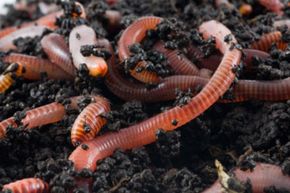Quck answer
Earthworms are essential for soil health, as they aerate soil, break down organic matter, and improve nutrient cycling. They do this through a combination of physical and chemical processes. Earthworms have a muscular body that they use to burrow through soil, creating tunnels that allow air and water to penetrate deeper into the ground. As they move through the soil, they ingest organic matter, which they then break down with the help of enzymes and gut bacteria. This process not only releases nutrients into the soil, but also creates channels for plant roots to grow. In addition, earthworms excrete nutrient-rich castings, which further enrich the soil. Overall, earthworms play a crucial role in maintaining healthy soils and supporting plant growth.
Animal Information
Categorizing Earthworms

Earthworms can be categorized based on their habitat in the soil.
Hemera/Thinkstock
Ground-dwelling earthworms can be classified into three main types depending on their location in the soil. These three categories of earthworms can typically be found by digging a few feet into the soil in temperate woodland areas in North America or Europe, where there is a layer of dead leaves covering the soil.
The first type of earthworm is the epigeic earthworm. These worms are found in the topsoil layer, where leaves mix with the soil. Epigeic earthworms play a significant role in breaking down organic matter, such as fallen leaves, by consuming them. Redworms, which are commonly used in composting, are a type of epigeic earthworm that are relatively small in size.
The endogeic earthworm is the second type, and they are found beneath the soil surface in the topsoil layer. Endogeic earthworms move parallel to the surface and create horizontal burrows. They feed only on organic material found underground, such as dead plant roots. Due to their underground life, they lack pigment and are usually pink, gray, or white. Endogeic worms are the least understood type of earthworm.
The third and most commonly known type of earthworm is the anecic earthworm. These earthworms live deep beneath the soil and create permanent burrows that can reach several feet below the surface. Anecic earthworms also feed on leaf litter, but they drag the whole leaves down into their burrows to consume them at their leisure. In one night, Lumbricus terrestris, also known as the night crawler in the United States, can travel up to 62 feet (19 meters) in search of food.
Earthworms belong to the phylum annelid, which means “ringed worm” [source: Raskoff]. They have 100 to 150 ringed segments that aid in their movement. Each ring can move independently, and the worms move by expanding and contracting their segments. At the front of the worm are retractable bristles called setae, which anchor the worm in place when necessary, allowing it to contract its segments and move forward. Earthworms can also move backward by extending their front and contracting their rear segments.
FAQ
1. What are earthworms?
Earthworms are invertebrates that belong to the phylum Annelida. They are segmented worms that live in soil and play a vital role in the ecosystem. Earthworms are hermaphrodites, which means they have both male and female reproductive organs.
2. How do earthworms help the environment?
Earthworms help to improve soil structure by burrowing through the soil. They create channels for air and water to flow through, which helps to aerate and drain the soil. Earthworms also break down organic matter, such as dead leaves and plant material, into nutrients that plants can use.
3. How do earthworms digest their food?
Earthworms have a simple digestive system that consists of a mouth, pharynx, esophagus, crop, gizzard, and intestine. When an earthworm eats, it ingests soil and organic matter, which is then ground up in the gizzard. The nutrients are absorbed in the intestine, and the waste is eliminated through the anus.
4. How do earthworms breathe?
Earthworms breathe through their skin, which is thin and moist. They need oxygen to survive, and they exchange gases through their skin. Earthworms can drown if their skin becomes too dry, which is why they prefer to live in moist soil.
5. How do earthworms move?
Earthworms move by contracting and relaxing their muscles. They have small bristles called setae on each segment of their body, which help them to grip the soil and move forward. Earthworms can also move backwards by reversing the direction of their muscles.
6. How long do earthworms live?
The lifespan of an earthworm depends on the species and the environment. Some earthworms live for only a few months, while others can live for several years. The average lifespan of an earthworm is 4-8 years.
7. What are the different types of earthworms?
There are more than 6,000 species of earthworms, but they can be grouped into two main categories: surface-dwelling and subterranean. Surface-dwelling earthworms live in the topsoil and feed on organic matter, while subterranean earthworms live deeper in the soil and help to improve soil structure.
8. Can earthworms be used for composting?
Yes, earthworms can be used for composting. This process is called vermicomposting, and it involves using earthworms to break down organic matter into nutrient-rich compost. Vermicomposting is a sustainable and eco-friendly way to dispose of food waste and other organic materials.





Leave a Reply